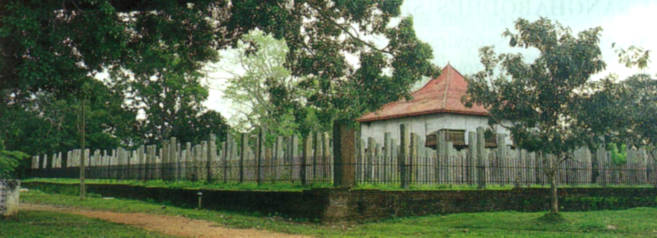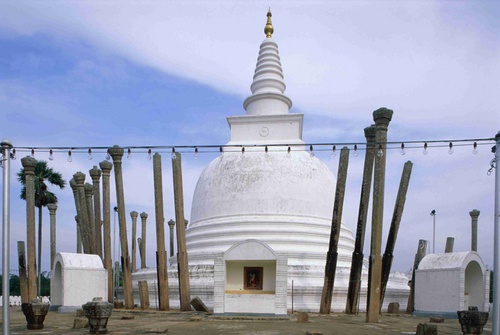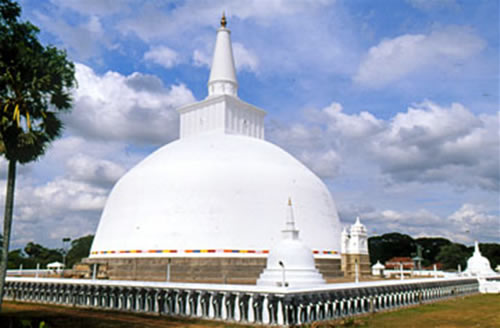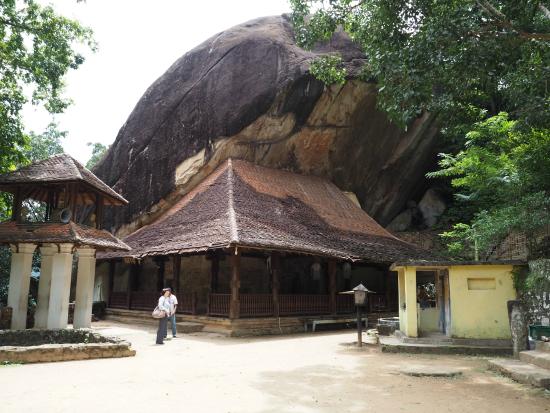One of the most evocative structures in Polonnaruwa, the Lankatilaka temple was built by Parakramabahu and later restored by Vijayabahu IV. This huge gedige has 17m-high walls, although the roof has collapsed. The cathedral-like aisle leads to a huge standing (headless) Buddha. Offerings of incense, and the structure's columns and arches add to the distinctly ecclesiastical, devotional atmosphere.
Sri Lanka is a beautiful island in the Indian Ocean. A diverse and multicultural country, Sri Lanka is home to many religions, ethnic groups, and languages. Majority is Sinhalese and Buddhist. The beauty of this tiny island is simply breath-taking. Known for its enchanting ancient ruins, endless soft-sanded beaches, imposing mountains, colorful festivals, tempting water sports, dense wild-life, Sri Lanka is bound to make you come back again.
Lovamahapaya - Anuradapura
Lovamahapaya was an ancient building located between Ruvanveliseya and Sri Mahabodiya in the ancient city of Anuradhapura, Sri Lanka. It is also known as the Brazen Palace or Lohaprasadaya because the roof was covered with bronze tiles.
In ancient times the building included the refectory and the uposathagara. As the roof was covered with tiles made of bronze, this was known as the Brazen Palace or Lohaprasadaya. There are 40 rows, each row consists of 40 stone pillars and a total of 1600 stone pillars were used for the building. The building was completely destroyed by a fire during the reign of King Saddhatissa.
In ancient times the building included the refectory and the uposathagara. As the roof was covered with tiles made of bronze, this was known as the Brazen Palace or Lohaprasadaya. There are 40 rows, each row consists of 40 stone pillars and a total of 1600 stone pillars were used for the building. The building was completely destroyed by a fire during the reign of King Saddhatissa.
Thuparamaya Temple - Anuradapura
This is the first stupa to be built in Sri Lanka, is believed to enshrine the collarbone Relic of the Buddha sent from India by Emperor Asoka after Anuradhapura converted to Buddhism. The Thuparama Stupa built by King Dewanampiyatissa, located in the heart of Anuradhapura.
We can imagine that there might be a colonnade which covered the stupa in a circular area which is also known as ‘Vata Dage ‘as the columns are still remaining around the Stupa. It was rewamped by the King Aggrabodhi the second who ruled around the 7th centuary.
Abhayagiri Vihara - Anuradapura
Abhayagiri Vihāra was a major monastery site of Mahayana and Theravada Buddhism that was situated in Anuradhapura, Sri Lanka. It is one of the most extensive ruins in the world and one of the most sacred Buddhist pilgrimage cities in the nation. Historically it was a great monastic centre as well as a royal capital, with magnificent monasteries rising to many stories, roofed with gilt bronze or tiles of burnt clay glazed in brilliant colors. To the north of the city, encircled by great walls and containing elaborate bathing ponds, carved balustrades and moonstones, stood "Abhayagiri", one of seventeen such religious units in Anuradhapura and the largest of its five major viharas. One of the focal points of the complex is an ancient stupa, the Abhayagiri Dagaba. Surrounding the humped dagaba, Abhayagiri Vihara was a seat of the Northern Monastery, or Uttara Vihara.
Ruwanweli Maha Seya - Anuradhapura
Ruwanwelisaya
is the one of the world tallest stupa, located in sacred city of
Anuradhapura. It was built by king Dutugamunu (140 B.C).It is standing
at 103 m (338 feet)with circumference of 290 m (950 feet)
Ruwanwelisaya is one of the 8 places of veneration in the Anuradhapura.
The Buddha's relics has been deposited in this sacred stupa.
Ruwanwalisaya is called various names such as Swarnamali Chaitya,
Mahathupa, Suvarnamali Mahaceti.
Today, after incurring much damage from invading Indian forces, it rises 55m, considerably less than its original height; nor is its form the same as the earlier ‘bubble’ shape. Its lowest circumference is usually wrapped in a strip of dazzlingly coloured cloth.
History of Anuradhapura
In 543 BC, prince Vijaya (543–505 BC) arrived in Sri Lanka, having been banished from his homeland in India. He eventually brought the island under his control and established himself as king. After this, his retinue established villages and colonies throughout the country. One of these was established by Anuradha, a minister of King Vijaya, on the banks of a stream called Kolon and was named Anuradhagama.
In 377 BC, King Pandukabhaya (437–367 BC) made it his capital and developed it into a prosperous city. Anuradhapura (Anurapura) was named after the minister who first established the village and after a grandfather of Pandukabhaya who lived there. The name was also derived from the city's establishment on the auspicious asterism called Anura. Anuradhapura was the capital of all the monarchs who ruled the country during in the Anuradhapura Kingdom, with the exception of Kashyapa I (473–491), who chose Sigiriya to be his capital. The city is also marked on Ptolemy's world map.
In 377 BC, King Pandukabhaya (437–367 BC) made it his capital and developed it into a prosperous city. Anuradhapura (Anurapura) was named after the minister who first established the village and after a grandfather of Pandukabhaya who lived there. The name was also derived from the city's establishment on the auspicious asterism called Anura. Anuradhapura was the capital of all the monarchs who ruled the country during in the Anuradhapura Kingdom, with the exception of Kashyapa I (473–491), who chose Sigiriya to be his capital. The city is also marked on Ptolemy's world map.
Sri Maha Bodhi - Anuradhapuraya
Today thousands of devotees come to make offerings, particularly on poya (full-moon) days and weekends. Sunset is a magical time to visit.
Hotel Topaz - Kandy
Hotel Topaz is nestled on top of Anniewatte Mountain. It provides a
spa, a large outdoor pool and elegant accommodation. WiFi is available
for free throughout the property.
All rooms are well-appointed with a tea/coffee maker, a hairdryer and
ironing facilities. They have luxurious beddings and large windows
which allow much natural light in. Spectacular views of the mountain are
enjoyed from guestrooms.
Amaya Hills Kandy
Located in the Cultural Triangle, Amaya Hills Kandy offers a hillside
retreat overlooking Heerassagala Forest. Featuring traditional Sri
Lankan architecture, it has an outdoor pool, a spa and a restaurant.
Air-conditioned rooms at Amaya Hills include private balconies with
mountain or valley views. Each room is fitted with a flat-screen TV and
tea/coffee making facilities. The attached bathroom has a bathtub and
shower.
Guests can exercise in the gym, or enjoy a game of squash or
billiards. The tour desk can arrange activities like bird watching
excursions, jungle treks and night safaris. Amaya Kandy also boasts a
night club called Le Garage.
Hotel Suisse - Kandy
Originally built as a ministerial residence, the Hotel Suisse in Kandy
exudes colonial charm and history. This 17th century colonial hotel,
with elegant rooms and delightful old school service, sits on the
beautiful grounds right on Kandy lake. The hotel is only a 15-minute
walk from the Temple of the Sacred Tooth and 10
minutes from downtown Kandy. The large rooms feature high ceilings,
elegant period furniture, balconies, gorgeous flower gardens, and lake
views. The in-house restaurant serves excellent Sri Lankan and Western
cusine. Please enter your dates on our secure online booking form to
make a reservation at Hotel Suisse.
Earl's Regency Hotel - Kandy
 |
 |
Earl's Regency Hotel is a luxurious 5-star hotel located a 5-minute drive from Kandy Railway Station. It offers spacious accommodation with a spa, an outdoor pool and free parking. Free Wi-Fi is available in the main lobby and Mount Batten Lounge & Spice Bar.
Air-conditioned guestrooms offer views of the surrounding mountainous countryside. Each room is equipped with a minibar, tea/coffee making facilities and a TV with satellite channels.
Air-conditioned guestrooms offer views of the surrounding mountainous countryside. Each room is equipped with a minibar, tea/coffee making facilities and a TV with satellite channels.
Appallagoda Ambalama - Kandy
The Appallagoda Ambalama is a traditional resting place situated in a rural environment in the village of Appallagoda, 6 kilometres from the city of Kandy in Sri Lanka. Built in 1922, it is an example of traditional, indigenous architecture and is known to be the largest stone built "Ambalama" in the Kandy region.
Galmaduwa Viharaya - Kandy
Traditionally ascribed to King Keerthi Sri Rajasinghe, it is said that while this building was being completed the king heard of the discovery of a cave at Degaldoruwa and stopped the work on Galmaduwa shifting his attention to Degaldoruwa. Sadly, in its unfinished state, this building was never used as a temple.
The Galmaduwa viharaya is an impressive building of strange architecture. As its local name suggests, it is basically a pavilion built of stone and brick. But a high gopuram gives it a Hindu identity. There is an ad mixture of Tamil-Hindu influence within the Buddhist place of worship.
The Galmaduwa viharaya is an impressive building of strange architecture. As its local name suggests, it is basically a pavilion built of stone and brick. But a high gopuram gives it a Hindu identity. There is an ad mixture of Tamil-Hindu influence within the Buddhist place of worship.
Royal Botanical Gardens - Kandy
Royal Botanical Garden in Peradeniya is near the Mahaweli River. The garden includes more than 4000 species of plants, including orchids, spices, medicinal plants and palm trees. The total area of the botanical garden is 147 acres. at 460 meters above sea level, and with a 200-day annual rainfall.
The origins of the Botanic Gardens date as far back as 1371 when King Wickramabahu III ascended the throne and kept court at Peradeniya near the Mahaweli river. This was followed by King Kirti Sri and King Rajadhi Rajasinghe. A temple was built on this location by King Wimala Dharma, but it was destroyed by the British when they were given control over the Kingdom of Kandy.
Hindagala Raja Maha Viharaya - Kandy
Hindagala Raja Maha Viharaya is picturesquely situated on a rock close to the University Campus at Peradeniya along the Galaha Road. Hindagala temple is very important place in Sri Lankan history since the Hindagala temple is related to many of ancient legends and amazing wall paintings. The architecture of the Hindagala Temple is also wonderful. The vihara geya is totally built under a natural large rock. You can see many of ancient architectural technologies such as "Kataram" and wooden joints.
Commonwealth War Cemetery - Kandy
The Kandy War Cemetery is a British military cemetery in Kandy, Sri Lanka, for most of soldiers of the British Empire who were died during World War II as well as a soldier died during World War I.
Lankathilaka Temple - Kandy
Background
Lankatilake Viharya built on the summit of a rock called
Panhalgala provides a magnificent panoramic view of the surrounding hills,
paddy fields and the diverse vegetation around it. On the temple premises are
the shrine, stupa and a Bodhi tree.
History
The temple has the same name as the well-known construction
of Parakramabahu I at Polonnaruwa. This is a religious devotion of Senalankadhikara,
a minister of Bhuvanaikabahu IV of Gampola in 1344 CE. Further establishments
in the form of stucco work carried out by the King, Parakramabahu VI of Kotte
(1412-1467 CE). The building was four storeyed during its glorious days.
However, today there is only the ground floor and a part of the first floor.
Gadaladeniya Temple - Kandy
Gadaladeniya Temple is located at Pilimathalawa, Kandy. Gadaladeniaya Temple was build by king Wickramabahu in 1344 during the Gampola Kingdom time. There are four pagodas (Dageba) you can see here and the main Dageba is covered with a roof. There are four small shrine
rooms around it with small dageba located top of each. The Boo tree is located in front of the dageba and there is a old inscription located by it. In the main shrine room has a large Buddha statue. This temple has some features of the south Indian
architecture.
Bahirawakanda Buddha Statue
The Sri Maha Bodhi Viharaya at Bahirawakanda is a very attractive and
mountain peak in the Kandy Town. The gigantic Buddha statue is about 88 feet in height. This is a very famous tourists
attraction in Kandy. This monastery temple was established in 1972. The
omnipresent Buddha statue seen panoramic view of Kandy town. The small gallery inside displays a collection of some magnificent pictures of Buddha’s life from baby to manhood.
Udawatta Kele Sanctuary
Udawatta Kele Sanctuary a historic forest reserve on a hill-ridge in the city of Kandy. It is 104 hectares (257 acres) large. During the days of the Kandyan kingdom, Udawatta Kele was known as "Uda Wasala Watta" in Sinhalese meaning, "the garden situated above the royal palace". The sanctuary is famous for its extensive avifauna. The reserve also contains a great variety of plant species, especially lianas, shrubs and small trees. There are several giant lianas. The important places in Udawatta Kele are the The water Pond, Highest peak "Kodimale", The Senkanda Cave, and the Garrison cemetery. There are also several Buddhist temples and hermitages inside the forest reserve.
Many of small and medium size mammals that inhabit Sri Lanka can be seen here. Several kinds of snakes and other reptiles might also be seen. Udawatta Kele was designated as a forest reserve in 1856, and it became a sanctuary in 1938. The Sri Lanka Forest Department has two offices in the reserve, one of which (i.e. the one located at the southeastern entrance) has a nature education centre with a display of pictures, posters, stuffed animals, etc. Being easily accessible and containing a great variety of flora and fauna the forest has a great educational and recreational value. Groups of school children and students regularly visit the forest and the education center.
Degaldoruwa Cave Temple - Kandy
The Degaldoruwa Temple was built in 1771 AD by King Rajadi Rajasinha and was initiated during the rein of his elder brother King Kirti Sri Rajasinha [1747-1782 AD].This is considered as a Cave Temple with Kandyan era Paintings and Architecture.
This temple is situated at Amunugama, a village near Kandy Town.The easiest way It can be reached from Kandy is via the roadway over Lewella Bridge or by proceeding along Kundasale road and turning left at Nattarampota.
The temple had been built at a place where two rocks were touching each other from above and below.The rock mass has a height of about 40 feet. A Cave had been made by breaking the rocks large enough to accomodate the Shrine Room of the Buddha and an area leading to the Shrine Room.
This temple is situated at Amunugama, a village near Kandy Town.The easiest way It can be reached from Kandy is via the roadway over Lewella Bridge or by proceeding along Kundasale road and turning left at Nattarampota.
The temple had been built at a place where two rocks were touching each other from above and below.The rock mass has a height of about 40 feet. A Cave had been made by breaking the rocks large enough to accomodate the Shrine Room of the Buddha and an area leading to the Shrine Room.
Ceylon Tea Museum - Kandy
It was in the Kandy district that the first successful experiments in tea cultivation were made, and it was from this ancient Sinhalese capital that the dominant modern industry of Sri Lanka spread out to cover the entire hill country. Kandy was thus the appropriate choice for a museum dedicated to the history of Ceylon Tea.
The Ceylon Tea Museum is located at the Hantane Tea Factory, about 5km. (3 miles) from Kandy. Hantane was one of the first areas successfully opened up to tea cultivation after the failure of the coffee enterprise, but the factory that now houses the Museum is a relatively modern building, constructed in 1925.
The Ceylon Tea Museum is located at the Hantane Tea Factory, about 5km. (3 miles) from Kandy. Hantane was one of the first areas successfully opened up to tea cultivation after the failure of the coffee enterprise, but the factory that now houses the Museum is a relatively modern building, constructed in 1925.
Bogambara Lake - Kandy
Kandy Lake is a lake in the heart of the hill city of Kandy, Sri Lanka, built in 1807 by King Sri Vikrama Rajasinha of Sri Lanka
next to the Temple of the Tooth. Over the years, it was reduced in
size. It is a protected lake, with fishing banned. There are many
legends and folklore regarding the lake. One such is that the small
island at its center was used by the king's helm for bathing and was
connected to the palace by secret tunnel.
Temple of the Sacred Tooth Relic
Temple of the Sacred Tooth Relic is a Buddhist temple in the city of Kandy, Sri Lanka . It is located in the royal palace complex of the former Kingdom of Kandy, which houses the relic of the tooth of the Buddha. Since ancient times, the relic has played an important role in local politics because it is believed that whoever holds the relic holds the governance of the country. Kandy was the last capital of the Sri Lankan kings and is a World Heritage Site mainly due to the temple.
Bhikkhus of the two chapters of Malwatte and Asgiriya conduct daily worship in the inner chamber of the temple. Rituals are performed three times daily: at dawn, at noon and in the evenings. On Wednesdays there is a symbolic bathing of the relic with an herbal preparation made from scented water and fragrant flowers called Nanumura Mangallaya. This holy water is believed to contain healing powers and is distributed among those present.
Subscribe to:
Posts (Atom)























